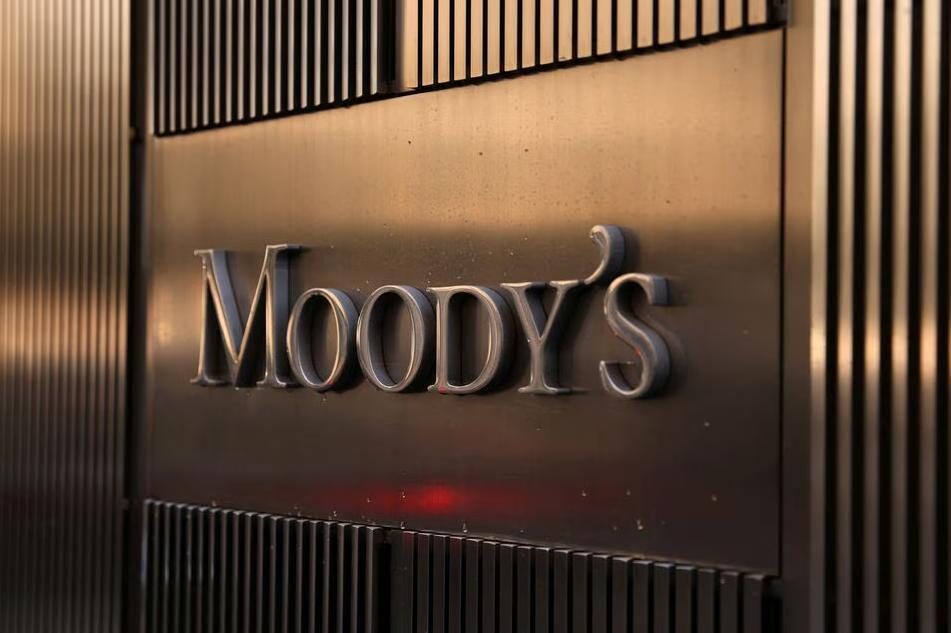Lananh Nguyen
ReutersWed, 09 Aug 2023 09:23 UTC

Signage is seen outside the Moody's Corporation headquarters in Manhattan, New York, U.S., November 12, 2021.
Moody's cut credit ratings of several small to mid-sized U.S. banks on Monday and said it may downgrade some of the nation's biggest lenders, warning that
the sector's credit strength will likely be tested by funding risks and weaker profitability.
Moody's cut the ratings of 10 banks by one notch and placed six banking giants, including Bank of New York Mellon (BK.N), US Bancorp (USB.N), State Street (STT.N) and Truist Financial (TFC.N) on review for potential downgrades."Many banks' second-quarter results showed growing profitability pressures that will reduce their ability to generate internal capital," Moody's said in a note.
"This
comes as a mild U.S. recession is on the horizon for early 2024 and asset quality looks set to decline, with particular risks in some banks' commercial real estate (CRE)portfolios."
Moody's said
elevated CRE exposures are a key risk due to high interest rates, declines in office demand as a result of remote work, and a reduction in the availability of CRE credit.
The agency also changed its outlook to
negative for eleven major lenders, including Capital One
(COF.N), Citizens Financial
(CFG.N) and Fifth Third Bancorp
(FITB.O).
The collapse of Silicon Valley Bank and Signature Bank earlier this year sparked a crisis of confidence in the U.S. banking sector, leading to a run on deposits at a host of regional banks despite authorities launching emergency measures to shore up confidence.
Comment: It looks like the crisis that was sparked earlier this year never really went away, it was just postponed; just a week ago Fitch downgraded the US from AAA to AA+:
Historic: US credit rating downgraded over rising debt, 'deteriorating standards of governance'And, in related news, a few weeks prior, both Henry Kissinger and Treasury Secretary, Janet Yellen, separately, paid a visit to China - notably Secretary of State Anthony Blinken's offer to pay a visit was rejected. China is known to be the country holding the 2nd largest amount of US treasuries, after US ally/vassal, Japan. China has also made it known that it's dumping treasuries at a record rate:
President Xi meets with China's 'old friend' Henry Kissinger in Beijing, Washington says visit was not on behalf of US gov'tThe following are a few statistics that can give a rather startling overview as to the health of the US economy:
The U.S. Now Has:
- 1. Record $17.1 trillion in household debt
- 2. Record $12.0 trillion in mortgages
- 3. Record $1.6 trillion in auto loans
- 4. Record $1.6 trillion in student loans
- 5. Record $1.0 trillion in credit card debt
Total mortgage debt is now more than double the 2006 peak. Meanwhile, 36% of Americans have more credit card debt than savings while student loan payments are set to resume for the first time since 2020. This is all while mortgage rates just hit 7.1% and credit card debt rates hit a record 25%. We are "fighting" inflation with debt. This can't end well.
For more on the downgrade by Fitch, and the role of the credit rating agencies, as well as their status within the US government, check out the following discussion by The Duran:




Meanwhile, the Federal Interest Expense Goes Exponential...
[Link]
The net result is that the interest on the national debt has reached nearly a trillion dollars or 3.7% of GDP.
To be fair to CBO, their projection of 3.7% of GDP by 2035 excluded intra-government debt (about 30% of interest payments). Adjusted for that, we are surprisingly close to where the CBO’s pre-Covid forecasts expected we’d be by now despite all that’s happened: roughly 2.6% of GDP.
The problem going forward [Link] that the CBO is still forecasting that the effective interest rate on the national debt will stay around 2.9% in 2024 (where it is now) [Link] only slowly rise thereafter to 3.2% by 2033 .
However, the entire treasury market is currently yielding over 4%, making that forecast a mathematical impossibility without a large move lower in rates. On top of that, the CBO is forecasting a $1.5 trillion deficit for 2023. For those keeping track, the trailing 12-month deficit is already $2.2 trillion and growing . [Link]
A recent sale of $38 billion of 10-year notes resulted in a higher yield of 3.999%, compared to 3.857% in July, with a huge demand for these Treasury [Link] securities. Fact: The market is demanding higher market interest rates...while the FED must keep their interest rates high to protect the dollar from imploding.
The punchline: the CBO’s gloomy outlook is optimistic, while the rest of the world is a mess and getting messier.
America is now a zombie state
[Link]
The United States of America is a slow motion train wreck.
There won't be a United States of America (as we know it) by 2033.